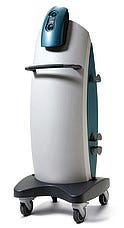May 9, 2009
Originally Published MPMN May 2009
ENGINEERING SOLUTIONS: MDEA
Cryotherapy System Provides Cool Treatment for GI Lesions
|
The Polar Wand system employs a cryogen to treat bleeding mucosal lesions in the gastrointestinal tract. |
When it comes to treating bleeding mucosal lesions in the gastrointestinal (GI) tract, physicians typically turn to thermal ablation techniques such as argon plasma coagulation (APC). Competition in the field is heating up, however, as the team behind the development of the MDEA-winning Polar Wand endoscopic cryotherapy system aims to freeze out thermal ablation methods.
Rather than ablating diseased tissue using thermal energy, the Polar Wand, manufactured by G.I. Supply (Camp Hill, PA; www.gi-supply.com), employs a cryogen—carbon dioxide—to coat lesions with a layer of ice. Treated tissue then sloughs off, allowing new, healthy tissue to grow in its place. Having demonstrated efficacy in patients for whom other treatment methods were unsuccessful, the system did not cause complications or pain during clinical studies, according to the company.
Upon licensing the cryotherapy technology from Johns Hopkins University (Baltimore; www.jhu.edu) several years ago, G.I. Supply sought to develop an endoscopic cryotherapy system that differed from existing technologies not only in its use of extreme cold, but through a simpler and more cost-effective design. “The modalities that are out there today are not at all that simple,” notes Monty Montague, principal for Bolt (Charlotte, NC; www.boltgroup.com), a long-time partner to G.I. Supply tasked with the user research, industrial design, engineering, and identity work for the Polar Wand. “But blowing a cryogen through a series of solenoids to an exact amount is a pretty complex thing. So, making the complex simple was a big part of the design.”
Making the complex simple translated into the creation of a minimalistic and user-friendly system. Clinicians simply plug the system’s disposable catheter into the mobile unit that houses the cryogen tank and controls, and then run it down the endoscope. With simplicity in mind, Bolt also engineered an evacuation system designed to automatically remove residual cryogen from the patient via a tube that runs over the top of the endoscope while cryogen is being deposited in the body.
Despite the simplicity of the user experience, the actual technology of the Polar Wand is fairly complex. Although stored under pressure in a liquid state in the tank, the carbon dioxide expands and cools rapidly to –78°C upon exiting the catheter. “Due to the Joule-Thomson effect, which is a rapid expansion of gas from a high pressure to a low pressure, there’s a drop in temperature,” explains Frank Carter, president of G.I. Supply. “It’s what enables us to be less expensive: [The CO2] is at room temperature until it comes out of the end of the catheter. You don’t have to add insulation or worry about storage of a cryogen such as liquid nitrogen.” Cost competitiveness is among the main advantages of the system, according to Montague. He states that the unit costs 50% less and the disposable costs 40% less than the comparable parts of an APC system.
In addition to lower cost, Polar Wand benefits also include a convenient, intuitive, and aesthetically pleasing design. Uncluttered and clean, the front of the mobile cart unit features only a few indicators, which clearly identify if the unit is on and whether the cryogen tank is full or almost empty. When the tank is running low, the unit emits a visual and audible alarm to alert clinicians that the tank needs to be changed. The back of the unit, on the other hand, is open in order to facilitate quick and easy access to cryogen tanks and the fluid-collection canister when replacement is required.
To take this user-friendly design to full-scale production, G.I. Supply contracted double MDEA-winning manufacturer Nexcore Technologies Inc. (Waldwick, NJ; www.nexcoretech.com). In addition to adapting the design for manufacturability, Nexcore provided liquid injection molding of the plastic cart components and overcame the challenge of incorporating additional capabilities into existing software without rewriting it.
All things considered, the design and development team behind the Polar Wand are satisfied with the final product. Comments Montague, “That was the goal: to come up with a system that could compete based on simplicity for the doctor, safety for the patient, efficacy for the patient, and [that is] cost competitive.”
Copyright ©2009 Medical Product Manufacturing News
You May Also Like



